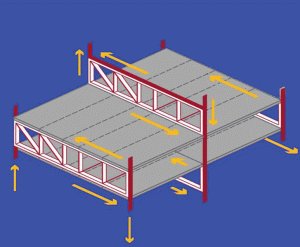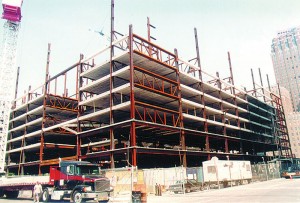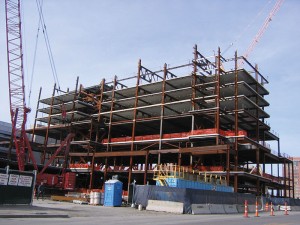The story of William LeMessurier’s engineering accomplishments was featured in the September 2012 issue of STRUCTURE magazine. The author, Richard G. Weingardt, quoted William Theon, a long-time personal friend and professional partner: “Bill loved teaching as much as engineering and was always at his best with an audience.” This is a chapter in Bill’s productive life not covered in Mr. Weingardt’s article – a time when he was working with students on collaborative projects, often sponsored by industry.
During the early 1960s, Bill lectured at the Massachusetts Institute of Technology (MIT) and was a key member of project teams that involved graduate students from the architectural and engineering departments. He wanted to give those students a chance to try out their theoretical training on real-life architectural and engineering problems, and let them receive financial benefits from corporate grants. Bill played a major role in one particular project sponsored by the Applied Research Laboratory (ARL) of The United States Steel Corporation (USS).
By 1960, the flat-slab concrete structural system had, for several reasons, virtually eliminated structural steel as a competitive material in high-rise residential construction. Concerned with this, USS charged the ARL with developing innovative ideas that might help regain a share of that market. Bob Hossli, an ARL research consultant and recent graduate of MIT, had been impressed with the team headed by architect Marvin Goody and engineer Albert Dietz that designed and tested the glass fiber reinforced polyester shells of the Monsanto-sponsored “House of the Future.” With this in mind, he suggested that MIT submit a proposal for an interdisciplinary research project to develop an economically competitive structural steel frame solution for high-rise residential buildings. This proposal was accepted, with Bill LeMessurier as the engineer and Marvin Goody as the architect on the team.
Several meetings took place without much progress. Then, as LeMessurier told it, one night, when he could not fall asleep, he had a “eureka” moment. Quoting from the USS Technical Report, Staggered Truss Framing Systems for High-Rise Buildings, he envisioned a
“… system … of story-high trusses spanning transversely between columns at the exterior of the building and arranged in a staggered pattern. The floor system acts as a diaphragm, transferring lateral loads in the short direction to the trusses. Lateral loads are thereby resisted by truss diagonals and are transferred into direct loads in the columns. Therefore, the columns receive no bending moments in the transverse direction. Columns can thus be oriented so that the strong axis is available to help resist bending due to longitudinal wind forces.
“The interior of the building is column free, and clear spaces are defined and limited only by intersecting floor and truss planes. Trusses are typically penetrated by one rectangular opening to provide a corridor space. However, other openings can be provided in the truss to allow for door opening if required by the architectural room arrangement.” (Figure 1)
Bill presented the idea to the MIT team, which accepted it heartily as the answer to the sponsor’s charge. In January 1967, the MIT team developed and presented to USS a thorough report about the system, how to design the structure, how to lay out various configurations for occupancy, and how to construct it. Upon review by ARL and USS’s Construction Marketing Department, in which Ron Flucker worked, it was judged to be immensely successful. The system would be extremely cost-competitive and adaptable to many floor layouts, could be built to the same height limitations as flat-slab concrete, and utilized rolled steel shapes as the principal structural elements. USS also recognized that the idea was patentable, but decided that it would be more in its best interests, and those of its structural steel fabricator customers, to keep the concept in the public domain.
The American Institute of Steel Construction (AISC) got wind of the concept through its Boston Regional Engineer and invited LeMessurier to present a paper describing the system at its June 1966 annual Engineering Convention in Boston. As a result of this early exposure, the firm of Bakke & Kopp, Inc. of Minneapolis decided to use the system for the frame of a local housing authority’s seventeen-story high-rise apartment building for the elderly, which was constructed in 1968.
U. S. Steel then began promoting the system and it caught on. Although no accurate count exists, it is estimated that some one hundred buildings (or more) have been constructed using the system, including one designed by LeMessurier’s firm, the Lafayette Place Hotel in Boston. While most buildings have been modest in size, typically 10 to 20 stories (Figures 2 and 3), some have bordered on monumental like the 30-story Resorts International Hotel in Atlantic City, which has withstood several hurricanes.
Bill LeMessurier’s “eureka” moment has resulted in a successful concept for high-rise steel framing. Perhaps more important to him was the learning experience provided for five graduate student assistants in the MIT Civil Engineering and Architectural Departments.
The authors wish to recognize the assistance of Tabitha Stine of AISC in researching this article and providing the accompanying images. All graphics courtesy of AISC.▪



